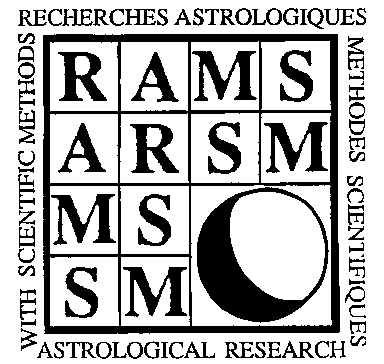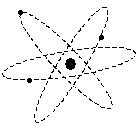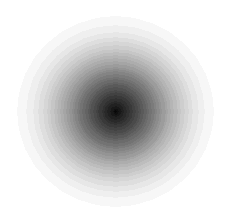|
|
Les Cahiers duRAMSIssue 15 - september 2007 | |
|
Abstract : Modern physics is dominated by the concept of quantum mechanics. The principles of quantum mechanics are – duality of wave and particle, probability, uncertainty, discreteness of energy, and contextual behavior. In this article, the author shows with examples how the principles of astrology are similar to quantum mechanics. If the research work on astrology is pursued on these principles, astrology will be accepted as a science by the scientific community.
|
Similarity between Quantum Mechanics and AstrologyTapan Das Ph.D., P.Eng. Quantum MechanicsQuantum mechanics is the science of matter and radiation at an atomic level. Classical (Newtonian) physics failed to explain very small particles (where quantum mechanics took over) and very fast particles of nearly the speed of light (where theory of relativity took over). Quantum mechanics corrects classical physics at the atomic and subatomic levels. The term quantum (Latin for quantity) refers to the discrete units that the theory assigns to physical quantities such as the energy of light and electromagnetic wave. Classical physics explained all physical phenomena in the world with two entities – matter and fields. Drop a stone from a bridge. The stone is made of matter. It drops because the earth’s gravitational field pulls it. Earth as a matter produces gravitational field which pulls the other much smaller matter like stone following Newton’s laws of motion. Scottish physicist James Clark proposed another field called electromagnetic field laying down the laws of electric and magnetic fields. Electricity and magnetism are not two separate fields but different aspects of a single electromagnetic field. Maxwell figured out that light is also an electro-magnetic field at certain frequencies. However, problem came with the classical physics in explaining why iron glows red around thirteen hundred degrees. According to classical physics, black bodies should glow bright blue at all temperatures. German scientist Max Planck solved this problem by proposing that matter particles do not vibrate any way they please, but at frequencies that follow the simple rule:
Where E is the particle’s energy, n is any integer, f is the frequency of the particle’s vibration, and h is the Planck’s constant. This was the first foundation of the quantum mechanics. Following this, the most celebrated scientist of the twentieth century Albert Einstein explained the photoelectric effect – light’s ability to eject electrons out of metal – using Max Planck’s quantum action. Einstein also showed that light consists of shower of particles called photons. While physicists were puzzling over the light’s seemingly contradictory properties - waves and particles, French physicist Louis de Broglie hypothesized that all entities have both wave and particle aspects. The wavelength of a photon can be obtained from its momentum by the formula:
where, p is the momentum, l is the wavelength, and h is the Planck’s constant. But, this wave function differs from ordinary waves in that it carries no energy. For an ordinary wave, the square of its amplitude measures its energy. For a quantum wave, the square of its amplitude at a certain location represents not energy but probability, the probability that a particle – localized quantum of energy - will be observed by a detector placed at that location. probability = (amplitude of wave function)2 The fundamental principle of quantum mechanics is based on the laws of probability, not laws of certainty. Probability is a measure of the relative number of ways an event can happen. The probability that a coin, when tossed, will come up heads is exactly ˝ or 0.5. But the result of any toss is uncertain. But, if we flip the coin enough number of times, say a million times, we will find that heads showed up very close to half a million times making the probability of heads almost ˝ or 0.5. Danish physicist Niels Bohr, who is considered the founder of quantum mechanics, proposed that electrons can exist only at discrete energy levels around the nucleus of an atom which prevents them from spiraling into the nucleus as classical physics predicts. Let us look at the picture of a hydrogen atom in its ground state. If we think that the electron is looping around the nucleus as shown in Figure 1A, then we are 80 years out of date. According to quantum mechanics, the probability density plot of the electron in hydrogen atom is shown in Figure 1B. The density of the dots represents the probability of finding the electron in that region. The size of an atom is ~1 x 10-10 meter. The central nucleus where 99.9 percent of the atom’s mass resides is ~1 x 10-15 to 1 x 10-14 meter. The size of an electron is not exactly known, but thought to be of the order of 1 x 10-14 meter. If the nucleus were the size of our Sun, then the hydrogen ground state would be twenty times larger than the solar system. If the electron were really a point particle moving around the atomic space, it would reside in a space so vacant that it would make solar system seem crowded. Now, if we consider the wave function of the electron with its probability density, then the probability density will fill up the whole atomic space. For instance, let us try to push our hand through a wall. Since atoms are mostly empty space, their electrons are too small to stop us. But, the probability density clouds of the atoms push our hand back. Pretty effective, aren’t they? German physicist Werner Heisenberg proposed uncertainty principle for the quantum mechanics stating that position and momentum of a particle can not be accurately determined simultaneously. If the position of the particle is accurately known, then the speed and direction of the speed will have poor accuracy. This is because the measurement itself changes the position or speed or direction of the particle. This is not obvious in the macroscopic world around us. If we want to measure the length of a table with a tape, the measurement does not change the length or position of the table in our acceptable measuring capacity. In the case of electron, measurement becomes different. The very act of looking at the electron with a super high power magnifier uses light made of photons. These photons would have enough momentum that they once hit the electron would change its course. Heisenberg wrote the uncertainty principle as:
On the right side is the Planck’s constant divided by 2p. Momentum is represented by
p, and position (distance) is represented by x. The D
symbols mean ‘uncertainty of’, not ‘change of’. Hence, Dx is the uncertainty of position, and
Dp is the uncertainty of momentum. Since
The attributes of an electron are contextual [1] depending on how they are measured. An example of a contextual attribute is the color of an object. If you go to a shop to buy a dress, the color of the dress you choose will depend on the light in the shop. If the dress you choose is white, but the light in the shop is bluish, then the dress will have the bluish tinge. Moreover, if you are wearing tinted glasses, then the color of the dress will also depend on the tint of your glasses. Hence, the contextual attributes of an object depends on the environment and the person observing or measuring it. AstrologyAstrology is based on the idea that the cosmic events happening in the universe affect the events happening in the Earth. The basic concept of astrology is that the planets and zodiacs affect the health and energy of a person. By studying the patterns and cycles of the planets and zodiacs, astrologers have gathered data thousands of years ago how cosmic patterns and events affect human life. The planets and their relationship between themselves and with zodiacs change constantly, but can be predicted accurately by mathematical calculations. Thus by comparing the position of the Earth to the planets and zodiacs, astrologers can explain the present event and predict the future. The cosmic energies that we know so far are the protons of elements of the periodic table. The dominant elements are hydrogen and helium along with other elements (lithium, beryllium and boron) with a few like carbon and oxygen. These cosmic rays on their way to the Earth are deflected by the electromagnetic field present throughout the galaxy. When these cosmic rays reach the Earth, they collide with the atoms of the upper atmosphere of the Earth releasing showers of gamma rays, X-rays and subatomic particles. There may be other of forms of cosmic energies reaching the Earth that are still to be discovered. Our Sun is producing energy bursts continuously not only in the form of heat and light, but as radio waves, ultraviolet rays, X-rays, and gamma rays. A solar flare is a sudden local explosion in a particular region of the Sun’s atmosphere releasing intense bursts of X-rays, ultraviolet rays, radio waves and energy particles [2]. A constant stream of electrons from the Sun is responsible for the Auroras on the Earth. The space surrounding the Sun and its corona is plasma. Each planet has a plasma sheath, the size of which is determined by the difference between the electric potential of the planet and that of the nearby solar plasma. The shape of the plasma is like a tear drop with the pointed end facing away from the Sun. The Sun and all planets except Venus and Mars have intrinsic magnetic field. There are strong “Dust Devils” in Mars which is a storm of highly charged particles. The planets and their satellites very close to the Earth also act as shields for the energy flow reaching the Earth. The effect of shielding of the Moon is particularly strong for the Earth. Thus the cosmic energies reaching the Earth are also affected by the solar system. How these energies affect a person is still to be understood. One theory is that it affects the biofield of a person. Modern science has confirmed that the human body is not just a physical structure, but is also composed of energy field. This biofield or human energy field (HEF) is the frontier of modern science, and the development of diagnostic and treatment systems. Dr. Victor Inyushin [3] at Kazakh University in Russia has done extensive research in the area of biofield and has suggested the existence of a bioplasmic energy field composed of ions, free protons, and free electrons. The bioplasmic particles are constantly renewed by chemical processes in the cells and are in constant motion. There is a balance of positive and negative particles within the bioplasma that is relatively stable. A shift in this balance causes a change in the person or organism. At the same time, some of this energy is radiated into space. Dr. George De La Warr and Dr. Ruth Brown built instruments to detect radiation from living tissues, and developed Radionics, a system of detection, diagnosis and healing from a distance, using the human energy field. They took photographs using the patient’s hair as antenna. These photographs showed internal diseases, like tumors, cysts inside the liver, and cancers within the brain. The biofield energy has been known in the past and has been called by different names in different cultures, such as qi in traditional Chinese medicine (TCM), ki in Japanese Kampo system, doshas in Ayurvedic medicine, prana in Hinduism. The imbalance in the biofield energy causes sickness and disease. This concept has been in the practice of many forms of therapy, like acupuncture, qiqong, ayurvedic, homeopathy, and therapeutic touch. Similarity between Quantum Mechanics and AstrologyLike quantum mechanics, astrology is also based on probability. Astrologers have collected data thousands of years ago how certain pattern of zodiacs and planets provide certain attributes. Sun sign represents the zodiac that the Sun is in at the time of a person’s birth. For example, the attributes of a person with Sun sign Aries is – leadership, energy, aggressiveness, courage, confidence, arrogance and belligerence. It does not mean that every Aries person will have these attributes. It means that the probability of an Aries person to have these attributes is higher than other Sun signs. The actual figure of probability is not quoted so far, but only be calculated statistically from very large numbers of collected data. The uncertainty principle of quantum mechanics applies to astrology as well. The Sun sign of a person means that the zodiac of the Sun sign, the Sun and the Earth are in line. The energy particles from the Sun sign zodiac and the Sun reach the Earth, and affect the people born at that time. But, the energy particles on their way to the Earth can be impacted by the electromagnetic fields and gravitational fields in the path, and the solar system as described earlier. Thus there is some uncertainty how much of these energy particles can reach the Earth. Similarly, there are some uncertainties on the attributes assigned to the Sun signs. These attributes have been based on the collected data so far. How extensive the data collection has been is not known and the attributes may change as more data are collected. If the uncertainty of the energy flow is DE, and the uncertainty of the assigned attributes are DA, then
As we see from Equation 1, the multiplication of the uncertainties of position and momentum in quantum mechanics equals Planck’s constant divided by 2p. In case of astrology, the values of astrology error and its constancy are not known. But, what is accepted so far is that there is a margin of error in astrology analysis and prediction. The contextual attributes mentioned in quantum mechanics apply to astrology as well. If the astrology prediction is that a person is going to win some money, then for a poor person living in poor neighborhood, winning $100 may be substantial and the neighbors might congratulate him. But, for a rich person living in rich neighborhood, this amount may be insignificant and will go unnoticed by the neighbors. Hence, the effectiveness of the prediction depends on the environment and the observers. Conclusion"I think I can safely say that nobody understands quantum mechanics." - Richard P. Feynman, US physicist. No one has yet claimed to understand quantum mechanics, but it has been successful so far in explaining the behavior of particles at the atomic and subatomic level. Einstein never accepted the probability theory of quantum mechanics. His famous saying – “God does not play dice”. He had constant debate with Niels Bohr about quantum mechanics, but they agreed that somehow quantum mechanics explains the behavior of atomic and subatomic particles. Couldn’t the same thing be said about astrology? First thing that should be realized that astrology is not certainty but probability. Second thing is that the astrology is based on the data collected over a certain periods few thousand years ago. That data collection has not continued; hence astrology attributes have not been updated. Astrology has not been accepted as a science by the scientific community. In order to get astrology accepted as a science, its basis should be similar to quantum mechanics – (1) duality of cosmic energies as particles and waves, (2) probability, not certainty, (3) uncertainty principle of cosmic energy flow and human attributes, and (4) contextual attributes. The scientific basis of astrology should be how cosmic energies affect human biofield. There are two limitations here. First, scientists so far know very little about the cosmic energies. Our universe is made up of 74% dark energy, 22% dark matter, and 4% ordinary matter consisting of baryons [4]. So far nothing is known about the dark energy and dark matter. Second, very little is known about human biofield, although currently some research work is going on. Until the study of human biofield is taken into mainstream scientific research, the full effect of cosmic energies on human will not be understood.
References
BiographyTapan Das has 35 years of technical management experience in telecommuni-cation, wireless, IP, WiFi and ASIC. He has worked as VP, Director and Technical Manager in SGNT Technologies, Lucent, Nortel and Plessey. He holds an M.Sc. in Electronics from the University of London, UK and a Ph.D. in Microwave Electronics from the University of Bradford, UK. He holds seven patents and has published number of technical papers in International journals. He had an active interest in astrology for a long time and has been researching astrology and cosmology for the four three years. He has published three papers on this subject in RAMS, Sep 2005, ISAR Vol XXXVI Number 3.and Journal of the Mindshift Institute. Figure 1A: Electron looping around the nucleus in hydrogen atom
|


